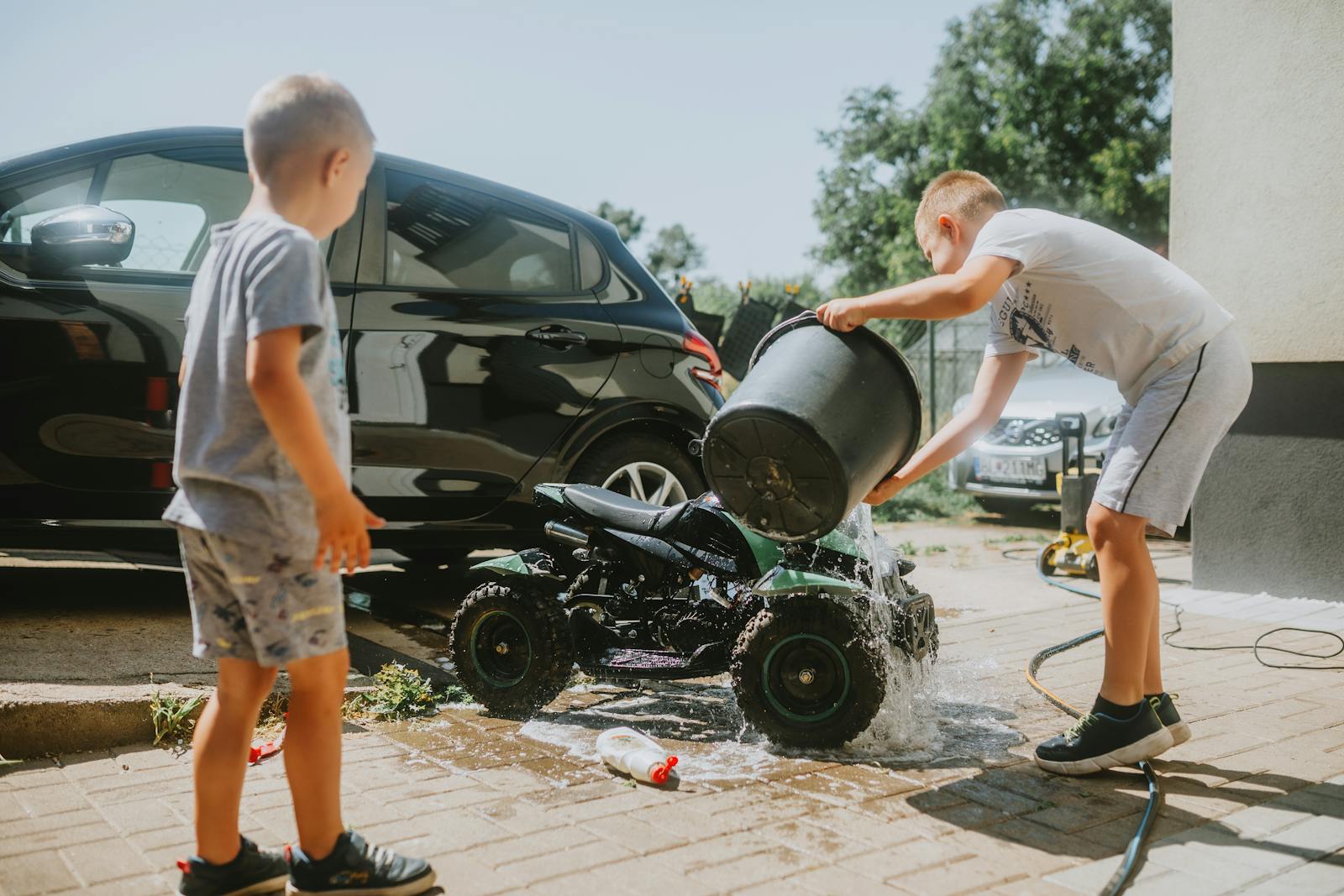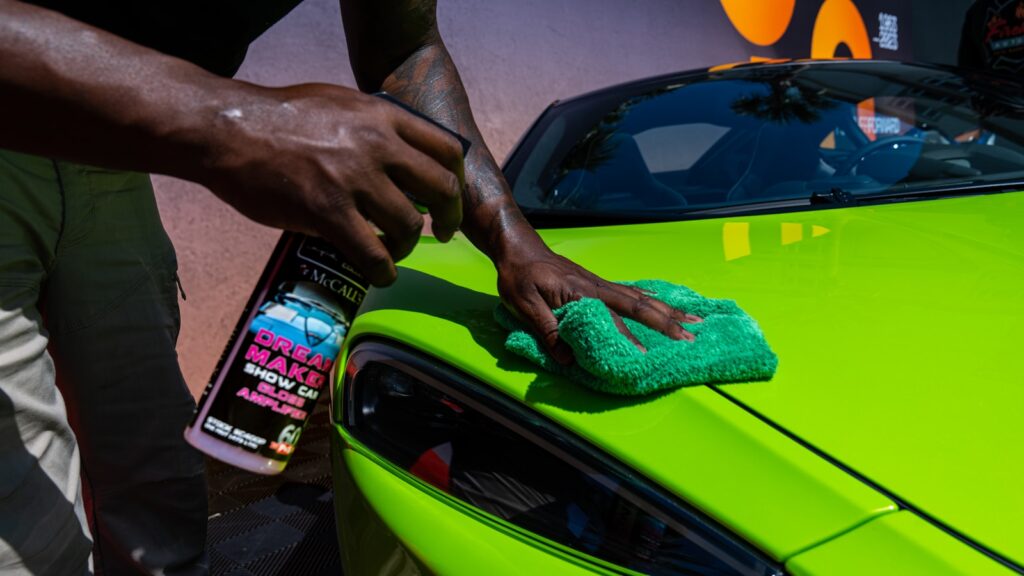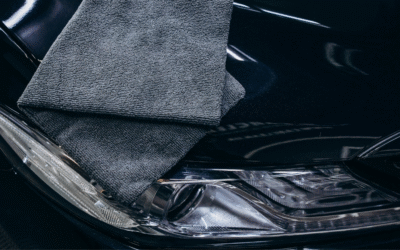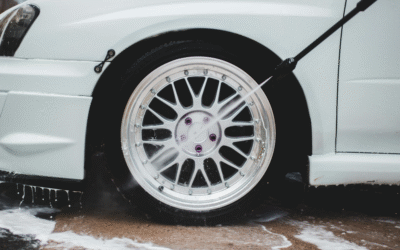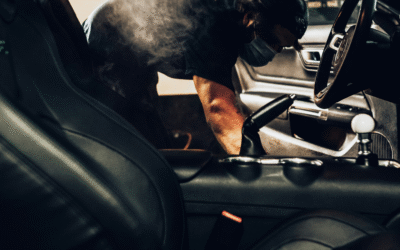At Fusion Car Wash, I know how important it is to keep your car clean year-round—especially here in Frederick, where fall means leaves, pollen, and road debris that can take a toll on your vehicle’s finish. While nothing beats the speed and shine of a professional wash, sometimes you want to roll up your sleeves and give your car some hands-on attention.
Washing your car at home can be more than just a chore; for many, it’s a therapeutic act and a great way to protect your paint job when you can’t make it to the wash. Taking the time to care for your vehicle yourself allows you to notice the little details and ensure every inch is spotless.
This guide is packed with professional-grade DIY car wash tips to help you achieve a brilliant shine right in your driveway. We’ll cover everything from the essential cleaning products to advanced detailing techniques that will keep your car looking its best through the fall season and beyond.
Of course, when you want that detail-level shine without the hassle, Fusion has you covered.
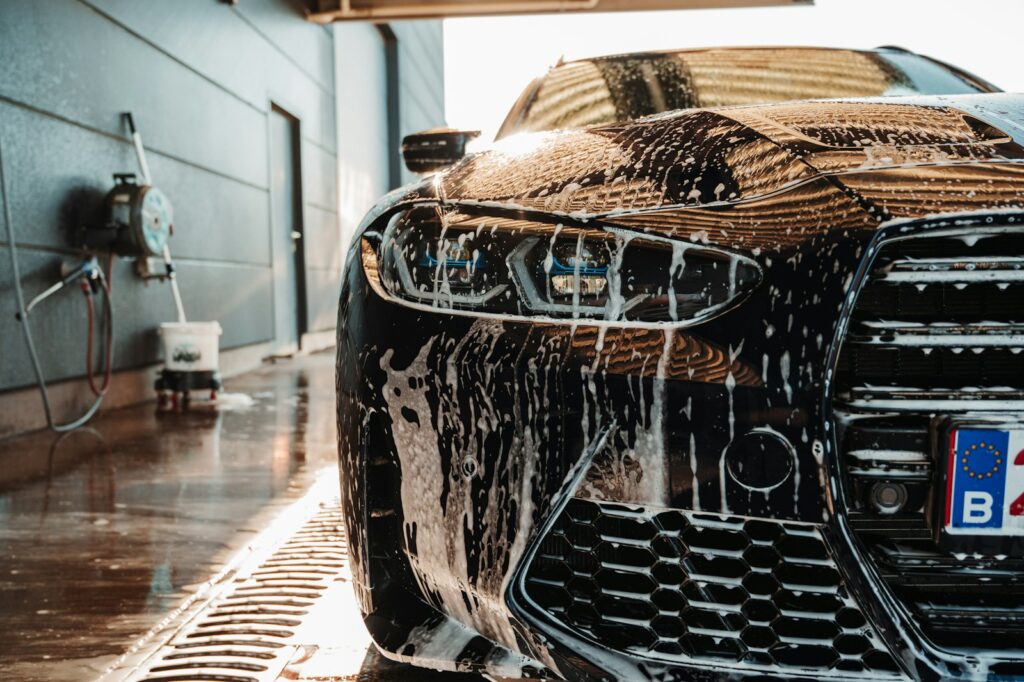
Photo by lucas clarysse on Unsplash
DIY Car Wash Tips Every Driver Should Know
Achieving a professional-looking wash at home starts with the right supplies and techniques. Before you even turn on the hose, a little preparation can make all the difference between a sparkling finish and a streaky, scratched mess. Here are the foundational DIY car wash tips to get you started.
First, gather your cleaning products. You don’t need an entire auto-detailing aisle, but a few key items are non-negotiable. You’ll want a high-quality, pH-balanced car wash soap, a soft wash mitt (preferably microfiber or natural wool), several clean microfiber towels for drying, and at least two buckets. It’s also smart to have a separate, dedicated set of tools for your wheels, which are often the dirtiest part of your car.
A crucial mistake many people make is reaching for household cleaners. Dishwashing detergent, hand soap, or all-purpose sprays are designed to strip grease and grime aggressively. While effective in the kitchen, these agents will also strip the protective wax right off your car’s paint, leaving it vulnerable to sun damage, oxidation, and environmental contaminants. Always use a soap specifically formulated for washing cars.
Next, consider your environment. It might seem logical to wash your car on a bright, sunny day, but direct sunlight is your enemy. The heat causes water and soap to evaporate too quickly, leaving behind stubborn water spots and streaks. UV light can also interfere with the performance of your car wash soap and wax. For best results, wash your car in the shade or on a cooler, overcast day.
Finally, be thorough. Pay attention to the often-missed tight spaces. Areas like rocker panels (the section below your doors), wheel wells, and the lower edges of your vehicle collect a ton of road grime. A clean car isn’t just about the shiny, flat surfaces; it’s about getting into every nook and cranny. Taking the extra time here is what separates an amateur wash from a pro-level clean.
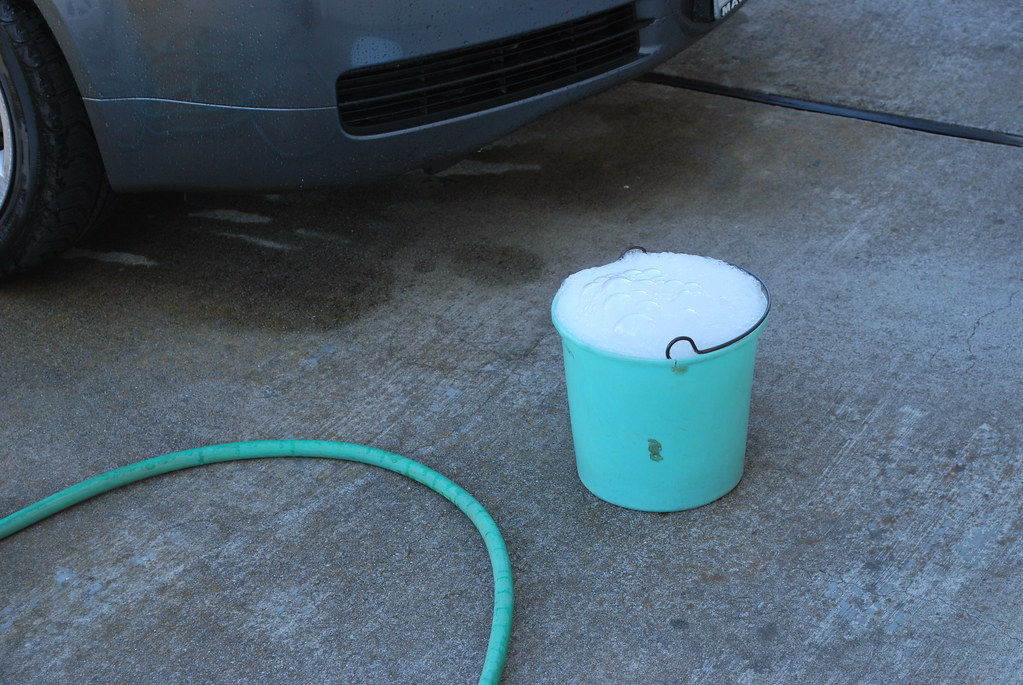
“Car wash bucket” by rocketlass is licensed under CC BY-NC-SA 2.0tr
The Two Bucket Method Explained
If you’ve ever wondered how professional detailers get a flawless, scratch-free finish, the secret often lies in a simple technique: the two bucket method. While it might sound basic, this approach is one of the most effective ways to protect your car’s paint during a hand wash.
So, what is the bucket method? It’s a system designed to keep the dirt you remove from your car from being reapplied and ground back into the paint. Here’s a breakdown of the one-bucket versus the two bucket method:
- One-Bucket Method: With this common approach, you have a single bucket filled with soapy water. You dip your wash mitt, wash a section of the car, and then dip the dirty mitt back into the same bucket for more soap. The problem? All the dirt, grit, and debris you just wiped off your car now contaminates your soapy water. Every time you reload your mitt, you’re picking up those abrasive particles and potentially rubbing them all over your car’s finish, creating fine scratches and swirl marks.
- Two-Bucket Method: This superior technique uses two separate buckets. One is filled with your car wash soap solution, and the other is filled with plain, clean water (your rinse bucket). The process is simple:
- Load your wash mitt with suds from the soapy water bucket.
- Wash a small section of your car, starting from the top and working your way down.
- Before getting more soap, rinse the dirty mitt thoroughly in the clean water bucket. Wring it out to release all the trapped grit.
- Now, with a clean mitt, go back to the soapy bucket for fresh suds and move to the next section.
- Wash a small section of your car, starting from the top and working your way down.
- Before getting more soap, rinse the dirty mitt thoroughly in the clean water bucket. Wring it out to release all the trapped grit.
- Now, with a clean mitt, go back to the soapy bucket for fresh suds and move to the next section.
By adding a dedicated rinse bucket, you ensure your soapy water stays clean throughout the wash. This dramatically reduces the risk of scratching your paint with the very dirt you’re trying to remove. For even better results, consider adding a grit guard to the bottom of each bucket. These plastic inserts trap dirt at the bottom, preventing your mitt from picking it up.
The best tools for this method are a soft, natural sea sponge or a high-pile microfiber wash mitt, a bucket filled with a quality car wash product, and, of course, plenty of clean water.
At Fusion, our signature six-step cleaning process works on the same principle—always protecting your car’s paint from loose dirt and debris. Our advanced systems ensure that only clean water and fresh, pH-balanced solutions touch your vehicle’s surface, giving you a safe and brilliant shine every time. To learn more about how to clean car windows for a streak-free shine, check out our detailed guide.
Tools That Make Washing Cars Easier
Having the right tools can elevate your DIY car wash from a weekend chore to a satisfying detailing session. While the two bucket method is a great start, a few extra gadgets can help you work faster, clean more effectively, and achieve that showroom look with less effort.
Here are some game-changing tools for washing cars:
Foam Cannon and Pressure Washer
A foam cannon is an attachment for a pressure washer that covers your car in a thick layer of soapy foam. This isn’t just for looks; the foam clings to the surface, loosening and lifting dirt, brake dust, and grime before you even touch the car with a mitt. This pre-soak step significantly reduces the risk of scratching the paint during the contact wash.
Microfiber Towels
When it comes to drying, ditch the old bath towels. Microfiber towels are specifically designed for automotive use. Their ultra-soft, absorbent fibers trap water without scratching the clear coat. Use a large, plush microfiber towel for drying the main body panels and smaller ones for door jambs, wheels, and windows.
Leaf Blower for Drying
One of the trickiest parts of drying a car is getting water out of tight spaces like mirrors, grilles, and emblems. A leaf blower (electric is best to avoid exhaust fumes) is a fantastic trick for this. Use it to blast water out of these hard-to-reach areas before it can drip down and leave streaks on your freshly dried paint.
Streak-Free Glass Cleaner
Clean windows are essential for both appearance and safety. Use an ammonia-free glass cleaner formulated for automotive use, as ammonia can damage window tint and interior plastics. Paired with a dedicated microfiber glass towel, you can achieve crystal-clear, streak-free results.
Tire Dressing and Wheel Cleaner
Your wheels and tires take the most abuse. A dedicated, pH-neutral wheel cleaner will safely break down brake dust and road grime without damaging your wheel’s finish. After cleaning, apply a tire dressing to give your rubber a rich, dark look that completes the car’s clean appearance.
Advanced DIY Detailing Steps
Once you’ve mastered the basics of washing and drying, you can move on to some advanced detailing steps to get your car looking truly pristine. These techniques address stubborn contaminants and add a layer of protection that keeps your car shining for weeks.
Clay Bar Treatment
Have you ever washed your car and noticed the paint still feels slightly rough to the touch? Those are bonded contaminants—tiny particles of industrial fallout, road tar, and tree sap that regular washing can’t remove. A clay bar is the solution. After washing and drying your car, you glide the clay bar over the paint with a lubricant spray. The clay gently lifts and pulls out these embedded particles, leaving the surface perfectly smooth. This is a must-do step before waxing, as it allows the wax to bond directly to the clear coat for better protection and shine.
Bug and Tar Remover
Especially during fall drives, your car’s front end can become a graveyard for bugs, while road tar can stick to your lower panels. These can be tough to remove with regular soap. Specialized bug and tar remover cleaning products are formulated to dissolve these stubborn spots without harsh scrubbing.
Scratch Repair
Minor scratches and swirl marks are almost inevitable. While deep scratches need professional attention, you can often fix light surface blemishes at home with a scratch repair kit. These kits typically include a fine-grit polish that gently levels the clear coat around the scratch, making it less visible. Always test on an inconspicuous area first.
Protective Wax or Sealant
This is the final and most crucial step for long-term protection. Applying a layer of high-quality carnauba wax or a modern ceramic-style sealant does more to protect your vehicle’s paint from deteriorating. These protective layers act as a barrier against harmful UV rays, water spots, dirt, and other potential contaminants. Additionally, they make it easier to clean your car in the future, as dirt and grime have a harder time adhering to the surface. Whether you choose a traditional wax or a ceramic coating, the key is consistency—reapply the product as needed to maintain its protective properties.
Popular Car Wash Products
When performing a hand car wash, having a dedicated car wash product on hand can enhance the cleaning process and protect your vehicle’s surfaces. Here are six top products and brands to consider:
- Meguiar’s Gold Class Car Wash: This premium wash shampoo is designed to produce rich suds that gently cleanse and condition the paint. Buy Here
- Adam’s Microfiber Wash Pad: A luxurious wash pad that safely lifts dirt and grime without scratching your vehicle. Its plush microfiber construction ensures optimal cleaning. Buy Here
- Chemical Guys Mr. Pink Super Suds Car Wash: Known for its intense suds and cleaning power, Mr. Pink is a versatile wash soap suitable for all paints and finishes. Buy Here
- Griot’s Garage Heavy Duty Car Wash: A highly effective, biodegradable formula that tackles tough dirt and grime while being gentle on your vehicle. Buy Here
- 3M Perfect-It Show Car Liquid Wax: Ideal for enhancing and protecting your vehicle’s shine, this wax provides long-lasting results. Buy Here
- Sonax Wheel Cleaner: A powerful cleaner specifically formulated for wheels, effectively removing brake dust and road grime without damaging the finish. Buy Here
Using these high-quality products will ensure that your hand car wash is as effective as possible, leaving your vehicle clean, shiny, and protected.
Final Tips for Paint Maintenance
- Avoid Automatic Car Washes – Many automatic car washes use harsh bristles or abrasive chemicals that can damage your car’s paint. Opt for touchless car washes or, better yet, a hand wash using the two-bucket method.
- Park Smart – Whenever possible, park your car in shaded areas or under covered structures to minimize prolonged exposure to the sun. This helps preserve the vibrancy of your paint and prevents fading over time.
- Clean Bird Droppings and Tree Sap Immediately – These organic contaminants are highly acidic and can eat through your car’s paint if left untreated. Keep a clean microfiber cloth and a quick detailer spray handy to address any issues on the spot.
- Regular Inspections – Take the time to inspect your car’s paint regularly for any chips, scratches, or blemishes. Catching these early allows you to address them before they worsen..
Additional Tips for Long-Term Paint Protection
- Invest in Quality Car Covers – If you don’t have access to a garage, consider investing in a high-quality car cover. It will protect your car from UV rays, rain, bird droppings, and other harmful elements when parked outdoors.
- Be Cautious of Automatic Car Washes – While convenient, automatic car washes often use harsh brushes that can scratch or dull your paint. Opt for hand washing or touchless car washes to minimize the risk of damage.
- Avoid Parking Under Trees – While it may provide shade, parking under trees can expose your car to sap, falling branches, or droppings from birds, all of which can harm your paint’s finish.
Taking care of your car’s paint is an essential part of overall vehicle maintenance. With a little effort and consistent care, you can keep your car looking like new for years to come. Whether you’re cruising around town or showing off your ride at a car meet, well-maintained paintwork will always make a lasting impression
By following these tips and incorporating them into your routine, you can ensure your car’s paint remains in top condition for as long as possible. Remember, a little extra care goes a long way in preserving your vehicle’s aesthetic appeal and value. Happy driving!

